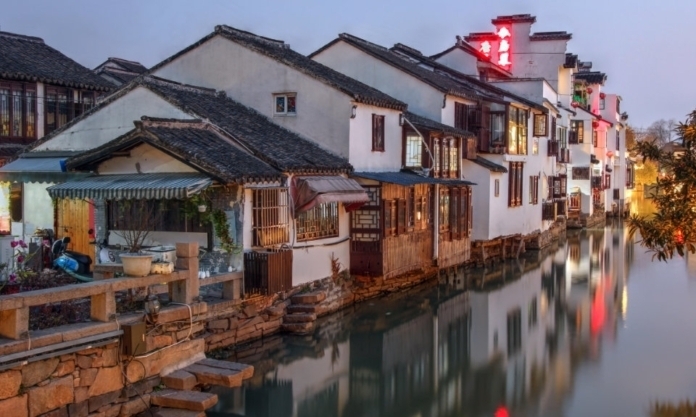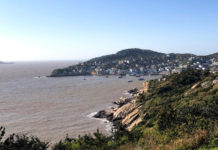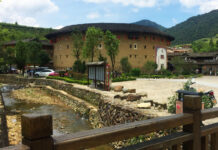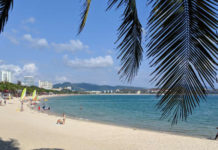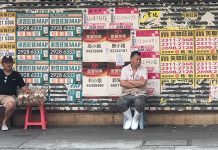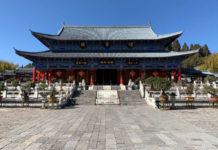Few words capture the spirit of Suzhou’s Pingjiang Lu better than “enchanting”. As a true step back in time, this is the place to relive the old, to find some authenticity that dates back as far as the Song Dynasty.
For many centuries, Pingjiang Lu has been the centre of much of Suzhou’s cultural life. A map from the Song Dynasty produced in 1229 CE teaches us that the road was already the ancient city’s main thoroughfare. Indeed, Pingjiang is one of Suzhou’s former names.
Despite being just a street away from the commercialism of Guanqian Street, 800 years on, Pingjiang Lu is still well-preserved today.
And that’s what brings in the tourists to this classical Jiangnan water village, communities defined by the intermingling of cobbled paths and canals.

It’s a veritable Chinese painting, one in which typical houses of ancient Suzhou stand simple and unsophisticated by the street, their white walls stained by the rain’s ink brushwork from their black roof tiles.
A shade over 1.6 kilometres long and running parallel with the Pingjiang River, the road is narrow, and with today’s tourists that means even a rickshaw has trouble getting through. On the water, only the slimmest of Chinese gondolas can effectively navigate.
They pass under no less than 18 arched stone bridges. Here, any self-respecting Suzhou bride shall sit for her wedding photos. For those unattached or wed long ago, these bridges provide for the perfect place for contemplation, reflections in the waters that have sat below for 800 years.

Listed in 2009 as a “Famous Historical and Cultural Street of China”, one of the first of nine such streets in China, Pingjiang Lu had in fact received an honourable mention from UNESCO 4 years earlier, when it scooped the Asia Pacific Heritage Award for Culture Heritage Conservation.
Sounds great, but eager foreign visitors should perhaps be forewarned. There’s a Starbucks. There are shops selling trinkets. There are museums and watering holes. Some are not ancient China, but Pingjiang Lu does know where the limit is to the extent that no one should be put off.
And in these old residences there is still no shortage art galleries, cafes, teahouses, opera houses and youth hostels with both dorm rooms and private accommodation for backpackers.
But just as interesting as the road itself are the alleys that lie off it. Some 51 of them, in fact. You won’t find any coffee chains here; instead it’s just simple life going on as it has done for centuries.
In these alleys, narrow and winding streets are protected by high walls on both sides to provide privacy for secluded gardens and residences beyond. It’s the very essence of Suzhou culture; a secluded life in the city serving as a contrast between the serenity of the private garden dwelling and the hustle and bustle of city life, with the modernity of everything the 21st century has to throw at it only serving to reinforce the juxtaposition.

Of course, Pingjiang Lu is not the only such street in Suzhou. In 2015, it joined Shantang Street in being two of 30 such scenic areas added to another list of national historic and cultural streets.
But a BBC Travel article has described Pingjiang Lu as perhaps the preferable of the two, it being less touristy than Shantang Street. The article furthermore states that Pingjiang Lu is “lined with houses that embody Suzhou’s style – graceful, simple and timeless. Pingjiang Lu gives an insight into the leisurely existence of the city’s residents. [It is a] centre of Suzhou’s artistic life, lined with bookshops and local opera theatres. There are also several teahouses, where people gather for performances of traditional storytelling and ballad singing”.
And let’s not forget the other activity which seems to be taking place at every corner along Pinjiang Lu; painting. In a setting so idyllic and serene, it is most difficult to distinguish whether people are painting or are a part of the painting.

A good place from which to start a visit to Pingjiang Lu is the Suzhou Museum, one of the most visited museums in the world, with its architecture by Pritzker Prize-winning architect, the late I.M. Pei. In addition to the delights therein, the museum also serves as a hint of what is to come.
Pei drew inspiration from Suzhou’s very soul; traditional white stucco walls adorned by sloping black roofs and, here and there, a splash of grey.
Nearby, no visit to the area would be complete by missing the Humble Administrator’s Garden, Suzhou’s largest classical Chinese garden and considered by some to be the finest example of such anywhere in southern China. Therein, the arrangement of rocks and water among the many pavilions and bridges are the very foundations of Feng Shui.

Developed over 1,000 years ago as rustic retreats from city life, Suzhou’s gardens became more elaborate over the centuries, designed for entertaining friends and displaying one’s mastery over design and décor.
Suzhou’s Pingjiang Lu is within walking distance from exit 3 of Xiangmen Station on Line 1 of the Suzhou Rail Transit system.


